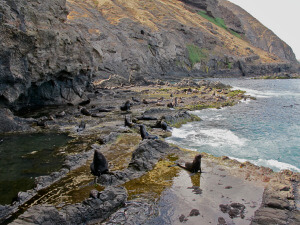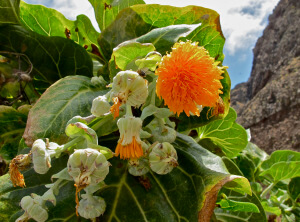Isla Santa Clara: Restoring Habitat for Pink-footed Shearwater
By Holly Freifeld
The zodiac's bow smacked the choppy water hard on the approach to the little island's landing site: a slippery, wave-washed tongue of rock. We each steeled ourselves for the scramble over the gunwale and onto the rocks in that unpredictable split-second when the boat, the water, and the shore all lined up. Crumbling basalt cliffs soared on either side, and the summer sun was scorching.
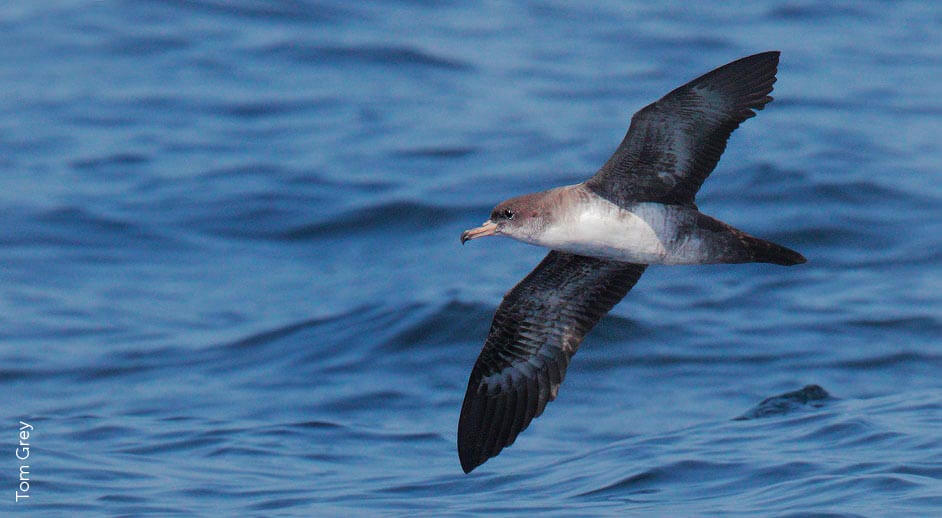
The rare Pink-footed Shearwater was the focus of this expedition to Isla Santa Clara, Chile. Photo by Tom Grey
Some devoted readers of the ABC blog may predict that this is Nihoa in the Northwestern Hawaiian Islands, home of endemic Millerbirds, Nihoa Finches, and a half-million or so seabirds, but no. This is a less fortunate sister in the Southern Hemisphere: Isla Santa Clara, in Chile's Juan Fernandez Archipelago.
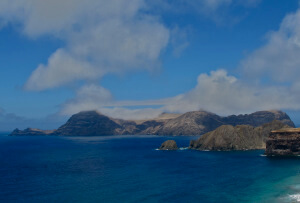
Isla Santa Clara, in Chile's Juan Fernandez Islands (33°S latitude; about 2.2 km2). Photo by Holly Freifeld
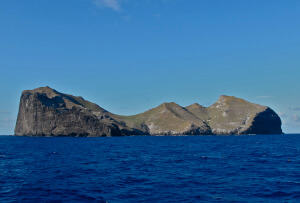
Nihoa, in the Northwestern Hawaiian Islands (23°N latitude; about 1 km2). Both Nihoa and Santa Clara are oceanic islands made of basalt (fragments of ancient volcanoes). Photo by Holly Freifeld
Gazing up past the eerily familiar cliffs, I sought the cloud of seabirds that whirls and floats above Nihoa and most of the other remote, uninhabited Pacific Islands I have visited. The sky was empty. The arid slopes were covered not with a mix of native shrubs, but a near-uniform golden blanket of what I would soon discover to be wild oats, Avena barbata, an alien invasive grass we all know from every walk in an American cow pasture.
Instead of carefully negotiating space with an endangered Hawaiian monk seal or two, landing on Santa Clara involves scattering dozens of Juan Fernandez fur seals, which in stark contrast with the monk seal, are enjoying a population boom in the archipelago, their only home.
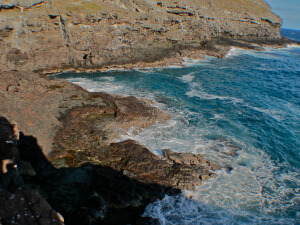
Nihoa landing. A handful of Hawaiian monk seals typically would be loafing on the rocks. Photos by Holly Freifeld
They're also far more fearful of humans than monk seals. As our boat nudged the rocks and one by one we variously leapt, hopped, slid, and fell onto shore, fur seals of all sizes did the same, into the water. Once we were ashore, the boat nosed cautiously back several times so that the crew (park guards with Chile's Corporación Nacional Forestal, or CONAF) could quickly pass our gear across.
As they waved good-bye and turned back toward the mile-wide channel that separates Santa Clara from Robinson Crusoe, we formed a fire-bucket brigade and ferried our gear across the rocky terrace and up to CONAF's cabin on a small flat shoulder maybe 130 feet above the sea.
For the next three days, Peter Hodum and Valentina Colodro of Oikonos Ecosystems Knowledge, Hector Gutierrez of Rescatemos Juan Fernandez (a local conservation group dedicated to control of invasive plants), and I would hike over the island and I would see for the first time nesting colonies of the Pink-footed Shearwater, known locally as Fardela Blanca, a seabird that Peter has been studying in the Juan Fernandez Islands for 14 years.
With funding from the National Fish and Wildlife Foundation and others, ABC has been working with Oikonos since 2009 on a variety of conservation projects for this globally threatened seabird, which nests only on Santa Clara and two other Chilean islands: Robinson Crusoe, just across the channel, and Mocha, a coastal island some 400 miles to the southeast.
Here on Santa Clara, the shearwaters nest in two or three well-defined colonies as well as in burrows scattered thinly around the island. Our job on this trip was to select and mark a subset of burrows in two colonies for monitoring through the breeding season.
Similar Islands, Different Histories
The non-native mammals (including humans) that prey on Pink-footed Shearwaters and munch on and trample their habitat on Mocha and Robinson Crusoe are absent from Santa Clara. The island once had feral sheep and rabbits, but these were removed by CONAF in 2000 and 2003, respectively. Although some of the island's native plants, including the strange and lovely cabbage tree, Dendroseris litoralis, have crept back in places around the island's margins since the last rabbits were removed, the damage wrought by herbivorous mammals – severe erosion and the near-complete loss of native vegetation – is still plain to see, and will require many years of hands-on restoration work to reverse.

Cabbage tree on Santa Clara. The small “forest” of these shrubs in the background on the left is an example of the modest natural regeneration of native plants around the edges of Santa Clara since rabbits were removed.
Santa Clara's climate is relatively arid, like Nihoa's, and the island's native vegetative may once have been similar to Nihoa's as well: a combination of shrubs, native bunch grasses and ferns, and perhaps small trees in ravines. Today the wild oats dominate the island (perhaps carried there in the guts of the sheep), as well as thistles, mustards, dock, and other weeds.
These non-native plants, all of continental origin, evolved together with mammalian herbivores and thus can survive in the presence of heavy grazing and browsing, and under conditions of increasing erosion and decreasing soil nutrients. The natives, for the most part, cannot.
The result, for the shearwaters, is dry, friable soil lacking the network of substantial roots that formerly provided structural integrity for their burrows through wet and dry seasons. Lacking stability, many burrows collapse. Peter estimates that Santa Clara now harbors about 3,500 breeding pairs of Pink-footed Shearwaters.
The degradation of the vegetation and substrate probably has severely reduced the Pink-footed Shearwater population on the Santa Clara; they likely once nested all over the island. Santa Clara does have a few other species of nesting seabirds, but these are not reliant on excavating burrows. Approximately 325 pairs of DeFilippi's Petrels nest in scree slopes or other rocky crevices on Santa Clara, along with a few Kermadec Petrels and White-bellied Storm-Petrels.
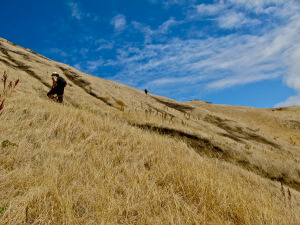
The landscape of Santa Clara is dominated by wild oats (Avena barbata), an alien invasive grass. The sheep, and rabbits, are gone, and the grass is thriving.
In contrast, Nihoa, which is less than half the size of Santa Clara, is home to probably 100,000 seabirds or more representing 16 species, including burrow- and crevice-nesters such as Wedge-tailed Shearwaters, Christmas Shearwaters, Bulwer Petrels, and Tristram's Storm-Petrels. Granted, biogeography, not human impacts, explains a lot of the difference in the number of seabird species between the Northwestern Hawaiian Islands and Juan Fernandez.
Too, Nihoa's topography is so extreme that soil development is patchy, and “traditional” burrow-excavators like Wedge-tailed Shearwaters nest mainly in rock crevices and small caves. The point, though, is the difference in the number of individual seabirds. Nihoa is covered with birds, as a rocky, oceanic island free of alien mammals should be. Santa Clara is by comparison woefully, echoingly, empty.
Restoration
Restoring native vegetation, and thus nesting habitat for Pink-footed Shearwaters, is the goal of ABC's work with Oikonos and CONAF on Santa Clara. The near-term objective is to establish native plants, rather than thistles and other alien species, in the two largest and most accessible concentrations of shearwater burrows on the island.
This is not a simple matter: getting to, and staying on, Santa Clara isn't easy or inexpensive, and little infrastructure currently exists on the island to support propagation and care of newly planted vegetation. The work underway now seeks to identify the most efficient methods, requiring the least time and technology, for reaching this objective.
I hiked Santa Clara with Peter, Vale, and Hector, alternately awestruck by the gorgeous, sweeping landscapes, and dismayed by the near-wholesale alteration of the island. Peter tells me that Isla Selkirk, the third of the Juan Fernandez Islands, is loaded with birds: hundreds of thousands of Juan Fernandez Petrels and Stejneger's Petrels. Selkirk also still has a fair amount of native vegetation, despite its small population of feral goats. Isla Mocha, the stronghold of the Pink-footed Shearwater breeding population, also has quite a bit of native forest.
The link between vegetation and seabirds can be critical on breeding islands. Native plants often provide essential structure, above and below ground, for nesting seabirds. That link has been weakened for Pink-footed Shearwaters on Santa Clara. With time, patience, and a lot of hard, hands-on work–propagation, planting, irrigation, and other support–habitat for this seabird can be restored, a bit at a time.
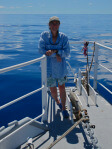 Holly Freifeld was manager of ABC's Seabird Program, following 10 years with the U.S. Fish and Wildlife Service focused on conservation of Hawaiian birds and Pacific seabirds. Prior to joining FWS, Holly participated in the study and conservation of island birds in American Samoa, Independent Samoa, Tonga, Palau, and California as well as in Hawaii. She holds an M.A. and Ph.D. in Geography from the University of Oregon.
Holly Freifeld was manager of ABC's Seabird Program, following 10 years with the U.S. Fish and Wildlife Service focused on conservation of Hawaiian birds and Pacific seabirds. Prior to joining FWS, Holly participated in the study and conservation of island birds in American Samoa, Independent Samoa, Tonga, Palau, and California as well as in Hawaii. She holds an M.A. and Ph.D. in Geography from the University of Oregon.





































